The Coaching Room: HubSpot Case Study
Contents
Section 1: Overview
Section 2: Current weaknesses
Section 3: Goals - marketing targets
Section 4: Content Strategy for 2018 to 2019
Section 5: Social Media Strategy
Section 6: Organic Traffic (2018):
Section 7A: New Lead User Journey to ‘Customer’
Section 7: Database Segmentation, and Lists
Section 8: Email marketing
Section 9: Pay Per Click, and related expenditure
Section 10: Sales Management
Section 11: Opportunities on the horizon/Recommendations
Section 12: The Team
Section 1: Overview
Section 1.1 Unique Selling Point
The Coaching Room is a training and coaching company based in Sydney and Melbourne, delivering Meta NLP
Section 1.2 Revenue
For the year 2016-2017, The Coaching Room’s revenue was $1.27 million , it then grew to $1.8 million for the following year (2017-2018) = 41.7% increase in revenue.
With a weekly sales target of 20 units, together the business is now striving to achieve $3,120,000
Section 1.3 Costs
During this time, there was an increase in Ad spend from $47,846 (2016-2017) to $75,239 (2017-2018). This increase in spend has remained for 2018, currently sitting at $55,815 2018 (start of year until 11th August)
In addition, marketing management costs increased September 2016 from $4500 a month to $6500 a month, going to $10,000 a month in July 2018 (with associated cost savings of a member of staff).
Note: other marketing costs within the business are less visible e.g. Mind Body Spirit festival exhibition stand, but should be built in to track ROI more accurately; also new designs on brochures should be factored in.
Section 1.4 New customers generated:
TRC’s sales come from new contacts, as well as upsells.
Growth in new contacts is essential for business success as otherwise we are mining a limited resource.
Customers from new contacts generated in 2016: 142
Customers from new contacts generated in 2017: 175
= 17.6% increase year on year
Customers from contacts generated in 2018 (to date): 87
Tracking per month, across all channels, available in this spreadsheet.
NOTE: we will see increased ROI for contacts generated for e.g. the new leads generated in 2018 that are currently moving through the funnel.
Section 1.5 Online/Offline Sales
This information comes from Hubspot, with ‘Sales Summary’ showing: (for this year so far)
$766,000 - offline (65%)
$417,000 - online (35%)
$82,000 - no deal type, is ‘up for grabs’ as an allocation
$65,000 - referrals are kept separate for this purpose
Breakdown here.
Note: Marketing is now involved in ‘offline sales’ as well as online e.g. running Leadership Practitioner campaign, and Master Practitioner campaign, CCMS campaign etc.
i.e. it is legacy naming (mentioned to fellow Directors) as ‘offline’ is really ‘existing customers’
Section 1.6 Lifetime Value
The Lifetime Value of a Customer - $9000+, hence the importance of sustaining people arriving into the funnel and starting that journey.
Currently, for leads generated by Adwords/Facebook in 2018 we are showing $1437 cost of acquisition - this will come down once more leads convert and more of those customers purchase ‘next products’, hence increasing ROI overall.
The average Cost of Acquisition for all customer sources in 2017, however, was worked out as circa $600, across all sources, with Organic/Direct and Referrals driving the average acquisition cost down.
The focus on increasing Direct Traffic and Organic results are essential for maintaining the overall reasonableness of acquisition costs.
Section 2: Current weaknesses
The main issues we currently face in marketing:
- Lack of brand consistency - esp. around images/themes
- Absence of relationship building with volumes of leads at lower stages (workflows/sequences)
- Hand-to-mouth feeling re: content scheduling for past 2 months (since ‘marketing admin’ handover)
- Lack of creativity when taking ‘NLP’ to market (see ‘Enneagram’ below as a comparison)
- We are lacking ongoing, quality backlinks (authority citations) to support website rankings
- ‘Reviews’ acquisition is patchy and would be better managed ‘in the room’ than by email
- Sales management and tracking still needs to be fully implemented to ensure leads are being best handled
- Social community management is ‘fine’ but quality relationship building across social channels is lacking
All of these are planned to be addressed over the coming months.
Section 3: Goals - marketing targets
Our primary metric in the Marketing team is the generation of MQLs (Marketing Qualified Leads), which get verified by the Sales Team (or through ‘event attendance’) and turned into ‘SQLs’ (Sales Qualified Leads).
Visibility on SQLs to customer conversion rates for last year is available in Hubspot, showing 44% conversion rate for last year once people reach this stage.
Section 3.1 Our goals for this 2018:
Our aim is to achieve 20 sales units per week; we aim to deliver 50% of them as ‘new customers’.
Here is the breakdown...
New customers: 10 sales units per week (50% of 20) = $30,000 a week revenue from new customers
MQLs generated per week*: 50 (i.e. 200 a month)
The average cost per acquisition of an MQL is $50
*MQLs = event bookings, ‘product brochure’ downloads, and ‘scoring over 50’ based on user activity e.g. call requests/email opens/clicks etc
Also, for more information here are the leads generated, per month, by source (click) we have a breakdown for ease of tracking.
Note: ultimately it needs to be SQLs generated from MQLs that is valued - if not, we would be focused on people ‘saying yes’ to an event, irrespective of them turning up.
Here is a snapshot of Leads generated from each source for last month, July 2018:
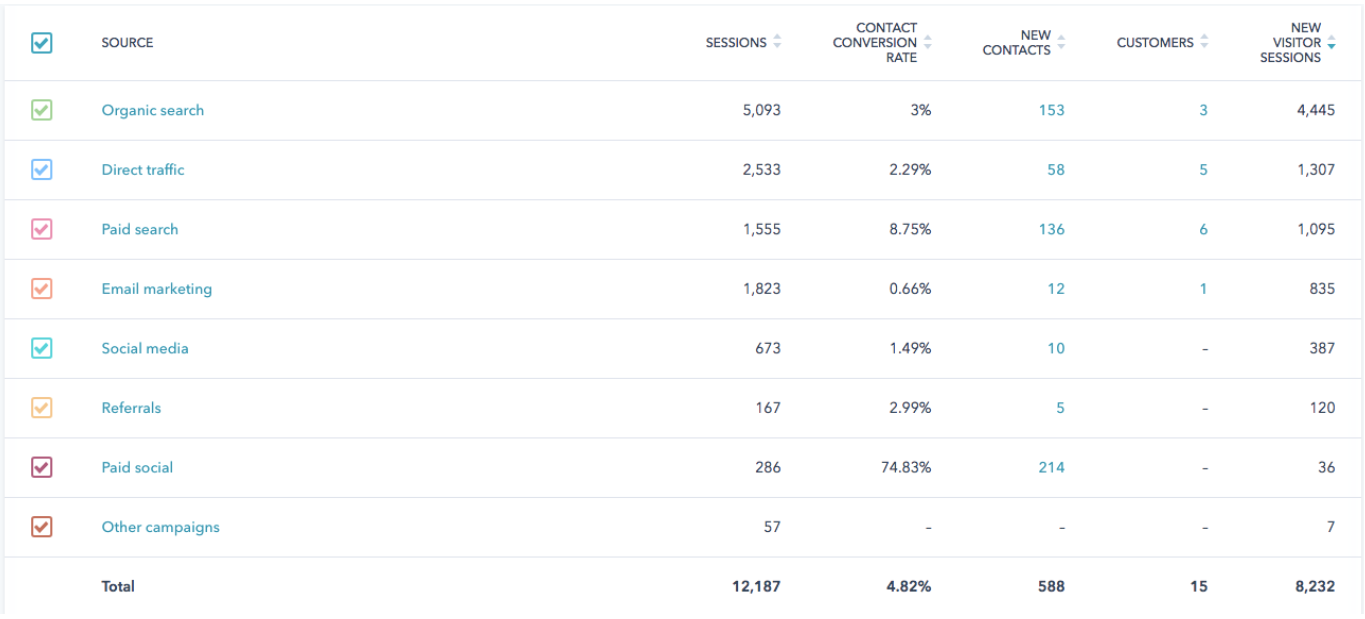
Note: paid social was an experiment ($1.50 leads), and would not usually be so high.
The monthly, safe average, for new contacts generated is ‘400’.
Section 3.2 Events:
This year we've implemented 2 hour Face to Face sessions in Sydney and Melbourne (with bookings being MQLs, and attendees being SQLs).
This has led to quickening the lead time from contact to customer:
This year: https://www.screencast.com/t/JCLBlCbT
Last year: https://www.screencast.com/t/1rjeRIwYc
I.e. shortening the funnel duration from Opt in to Customer.
Focusing on ‘event bookings’, in June we ran 2 hour sessions for Leadership and Coach Training, but neither were successful (but we plan Coach Training to emerge again once Sale Proposition is tighter). As such, this model below can be considered for 2 hour NLP info (sales seminars) run in Sydney, Melbourne, and Hobart.
The basic model (at Matt Joy’s request) is targeting 750 sales per year from events = 62.5 sales per month
Right now, we are moving 200 MQLs (bookings) to 100 SQLs (attendees), to circa 20 sales per month.
As such we are tightening the funnel so that:
a) Attendees on the night are converted better i.e. to get 33 in every 100
b) Non-attendees are better followed up and converted,
c) Attendees are followed up and converted
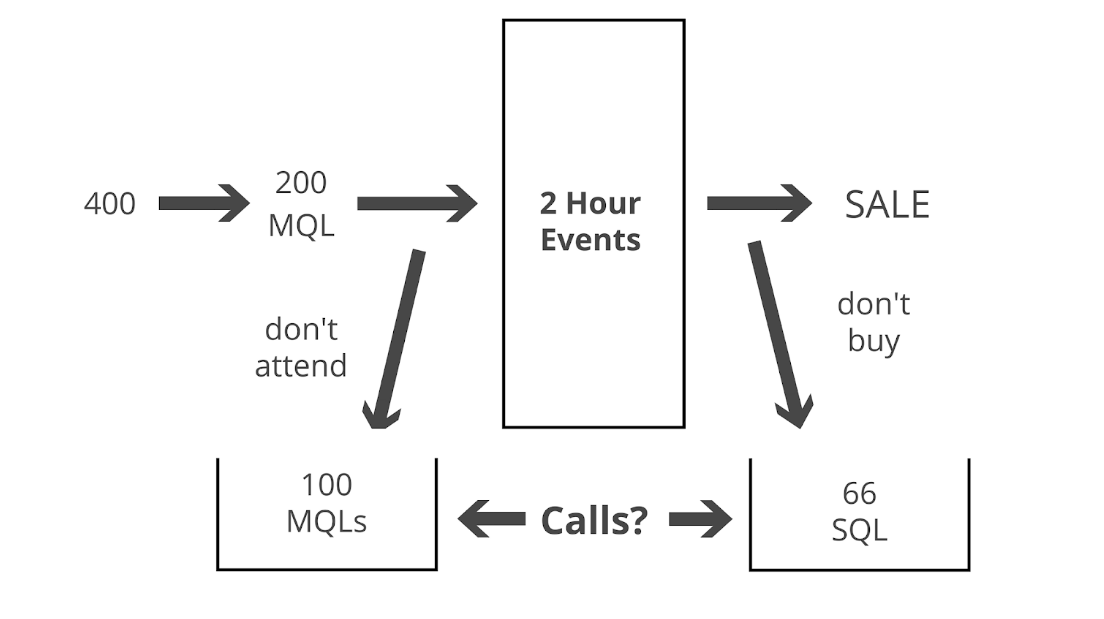
Looking at a more accurate reflection of the overall TCR funnel below:
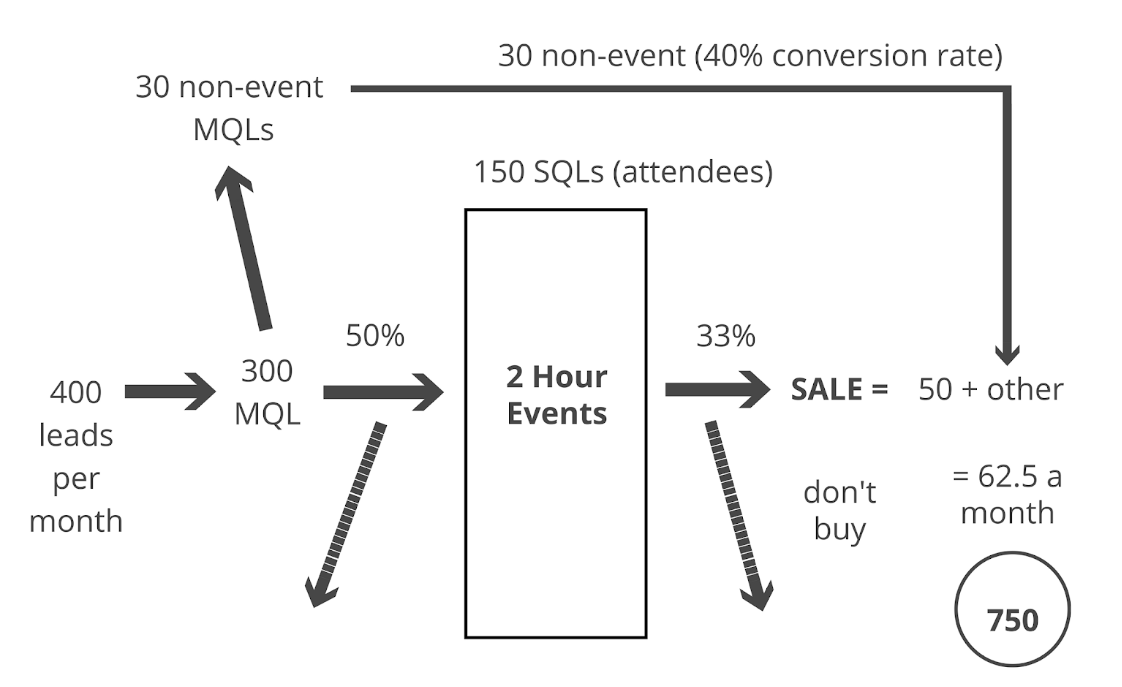
We bi-pass the ‘events’ route when a lead is already warmed up to e.g. NLP Practitioner, or The Coaching Training pathway (i.e. 30 MQLs from this source - converting 40% by top sales people). Attending an event can still be offered by the Sales team when they connect.
We need an additional 100 quality MQLs per month, with 50% attendance rate (which it was at the last Sydney session in July), with a conversion rate of 33% to yield 50 sales.
Add this to the ‘bi-passed sales’ (i.e. keener, more educated purchasers), and we can achieve 62.5 sales per month from new contacts with attribution to marketing.
Using cost effective lead acquisition methods (see below) we are working toward 300 MQLs a month by end October.
Section 3.3 Considerations
In terms of ‘breakdowns’, we are optimising each stage of the process to increase conversion rates. This includes:
- Sales team connecting with people prior to events (phone/email)
- Tracking open rates of confirmation emails; using text follow up to increase likelihood of attendance where appropriate (not bombarding)
- Increasing conversion in the room (James, and the delivery team)
- Non-attendee follow up - giving alternatives to the event to gain more knowledge (e.g. ebooks, meeting, brochure, and soon ‘webinars’)
- ‘Attendee non-purchaser’ follow up by the sales team
Section 3.3B
The greatest resistance(s) for purchasing personal and professional development products and services are as follow (with their ‘objections handled’:
- “Not enough time to train!” (You need to make time to develop yourself)
- “Not enough money!” (This is an investment, that gives you XYZ in value, and we can do payment plans).
- “Thinking of going to another provider…” (Sure, I’ve heard they are really good. But why don’t you chat within one of the community that’s done both types of course? etc)
- “You seem to be more about ‘Business’, or more about ‘Spiritual’” - depending what they’ve seen. (NLP is a tool kit of skills that you can apply in all areas of your life - a bit like electricity, you can plug in and supercharge the areas you want).
- “Now it not a good time…” (What would have to happen for you to take a leap? What are you waiting for?)
Section 3.4 Product Verticals:
We segment contacts based on their main interest as follows:
NLP
Coach Training (Become a Coach)
Leadership
Executive Coaching
Other (Enlightened Parenting)
Corporate Training

There are also additional programs, upsells, e.g. ISFC, Spiritual Retreat, Parenting, Leadership Practitioner
A map of numbers of people booked on all upcoming courses is here: upcoming course numbers
Section 4: Content Strategy for 2018 to 2019
There are several purposes to creating content, including:
Creating tantalizing content to increase initial conversions
Content to enable better decision making as to products/services we offer
Content to re-engage visitors who haven’t opted in on the initial offer
Content for existing customers and community members
Content to increase the breadth of the semantic footprint of TCR, and deepen the impression of that print in Google Search i.e. more results, higher ranking results
This largely is done through an extensive blogging calendar and ideas from Keyword volumes are captured here.
There is activity 5 days a week: we release 2 to 3 blog posts every week; additionally, since end August we are posting ‘quote posts’ on the days we don’t post a blog - these posts include information on upcoming courses.
Section 4.1 SEO Methodology
In 2018, we refocused our content strategy to better integrate our approach to SEO, generating contacts within each vertical. Top level view here.
Alongside a content strategy, we applied an aggressive SEO approach in March 2018, which has yielded positive results (see section on Organic traffic),
This approach included:
Backlinks from high authority sites (owned by myself)
Increasing citations from less than 10 to 217 sites
Increasing number of quality reviews on Google Adwords and Facebook
As well as on-site changes
Section 4.2 Increasing conversions
This document (already cited) gives a perspective on Contact/Customer conversion per channel.
We continue to optimize the pages, using A/B testing to increase conversions - but the main issue we face has not been number of opt ins, it has been the next stage in the funnel.
Section 4.3 Ebooks
We have an library of content, and regular updates based on new courses/approaches.
They are comprehensive and visually appealing e.g.
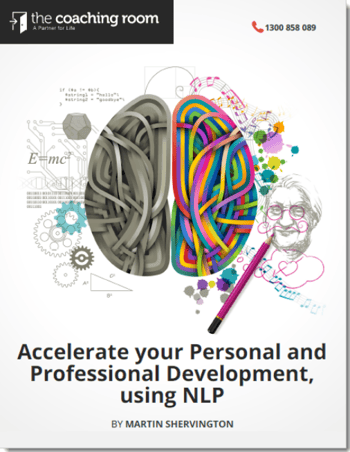
Section 4.4 Video
Our main gap in content right now is VIDEO, and something that needs building out over the coming months. Our catalogue of personality type videos were very well received, and this approach needs to be taken more broadly for ‘NLP’ and ‘Coach Training’ - with the aim of driving traffic/gaining opt ins.
Section 4.5 Infographics
We’ve used highly visual content, as in this case and created infographics based off that style. For both NLP and Coach Training user journeys we could do with leading the way with a more vibrant visual style.
Section 4.6 Quizzes
TCR has developed several quizzes, including a very well received (and now highly accurate) Enneagram quiz, and Learning Styles, and ‘4 Quadrants’.
Section 4.7 Consistent image themes
Across emails, product pages, blog posts and adverts we apply a consistent approach to imagery e.g.
Parenting we used ‘paper cut outs’ - product page, sample blog 1, sample blog 2 - the same was rolled out for emails/ads.
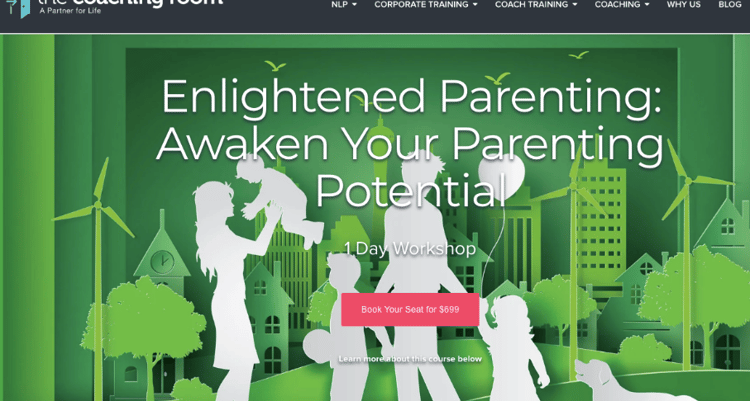
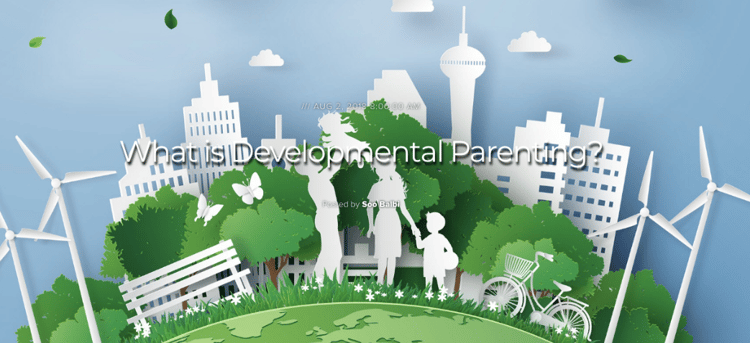
This principle allows for better continuation of the product narrative for the campaigns.
By applying such rules to all products e.g. Stylised ‘Brain’ images for NLP, we can better ensure consistency - creating more trust in the minds of the reader/contact that ‘this product’ is the same each time.
There is still work to be done in this area.
Section 4.8 Quote Posts (new from end August)
Since starting the ‘quote posts’, shares and likes have increased (e.g. 6 likes/10 shares).
People like quotes.
By adding in the ‘upcoming course information’ as links, we are now better using Social to move promotions across the network.
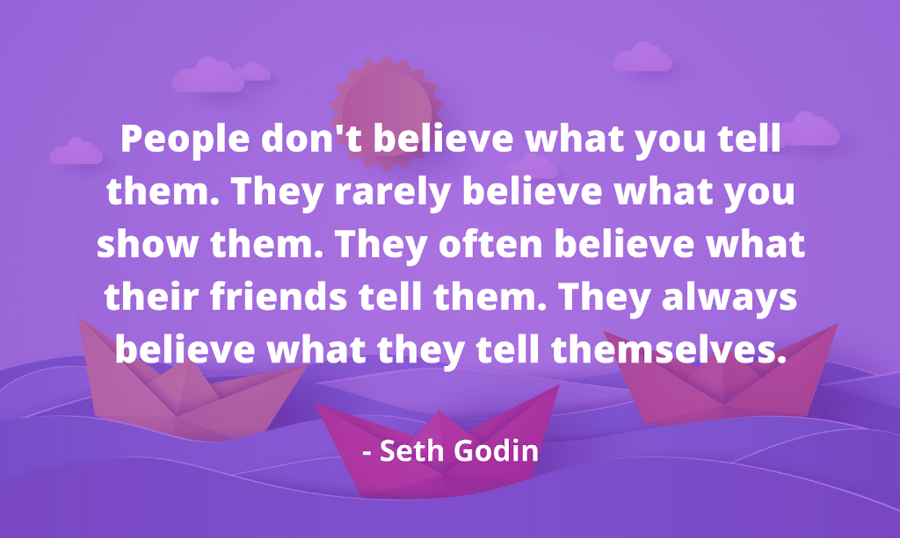
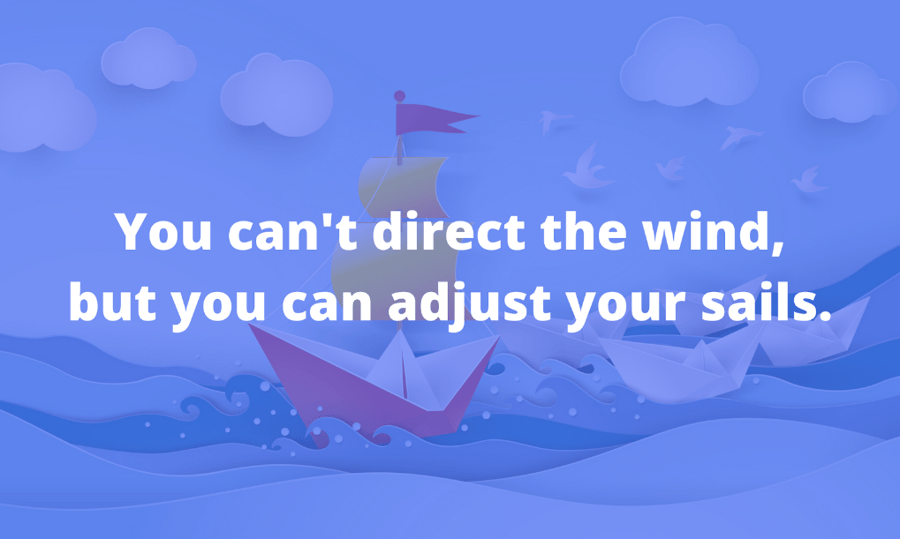
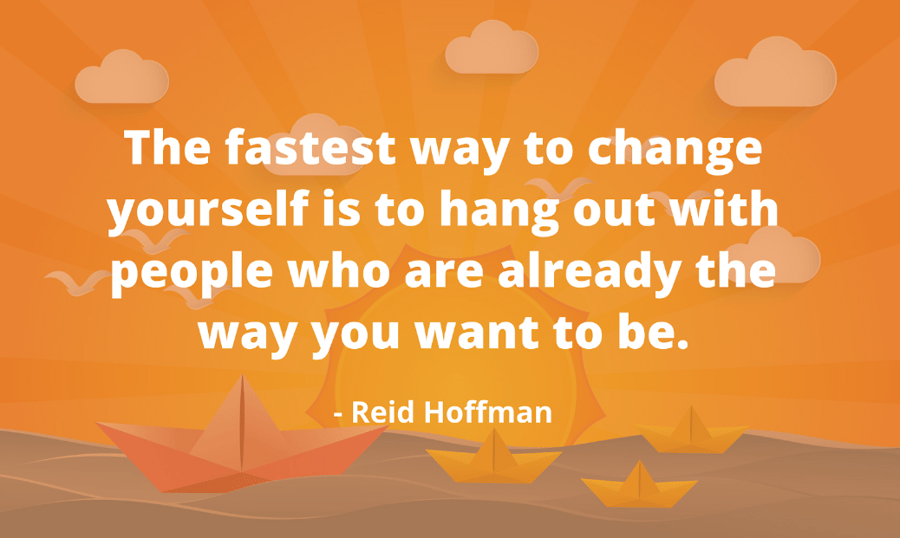
We are next testing ‘click throughs’ from the promotional links (and sign ups to promo events) as this is ultimately more valuable than ‘brand’ alone.
Section 5: Social Media Strategy
Overview 5.1A
Right now we use Social Media at a value of 6, on a scale of 1-10.
The information below will give you an explanation...
Section 5.1 Facebook
The Facebook Page has 2500 likes, and ‘some’ engagement on posts
There are 236 reviews with a rating of 3.6 out of 5 - lower than it should be due to a fake reviews attack, and something we are driving up over a score 4 through an email campaign.
Boosting posts increases exposure, but is not as sophisticated as other Facebook Ads:
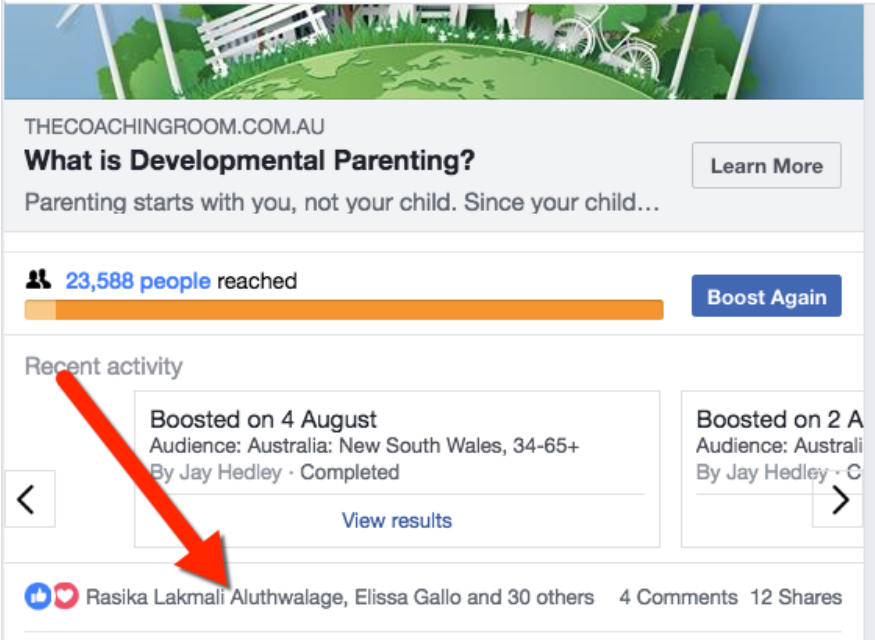
Section 5.2 Facebook community
This is TCR’s digital home - with a community of over 480 members, who have completed NLP Practitioner (or beyond).
There is regular posting by community members, esp. Photos of events.
We used to run weekly video events, but the ROI of time Director’s time was not direct enough to continue - knowing people in the community were already ‘bought into’ live face-to-face events.
Note: please refer to the ‘webinars’ bullet point in the ‘Opportunities/Recommendations’ section.
Section 5.3 LinkedIn
This is currently underutilised in several ways.
We distribute content but in more of a ‘broadcast fashion’ than attempting to start a conversation.
Instructions were given to the Directors on how to build a network on LinkedIn, but it is time consuming to do well. Instructions here.
We have a Women in Leadership group that is largely unmanaged.
A new resource has been brought in to support in organic and paid outreach in this area. She will be connected with shortly so we can coordinate content creation/distribution efforts.
Section 5.4 Google+
This used to be my preferred network, but now we only broadcast.
I have high personal authority ‘there’, with a network of 1.4million followers - so when we can I share to increase the speed that content is indexed.
There is no benefit in splitting attention to new platforms when Facebook will work well.
We do however need to ensure Google Maps is well optimised...
Section 5.5 Google Maps
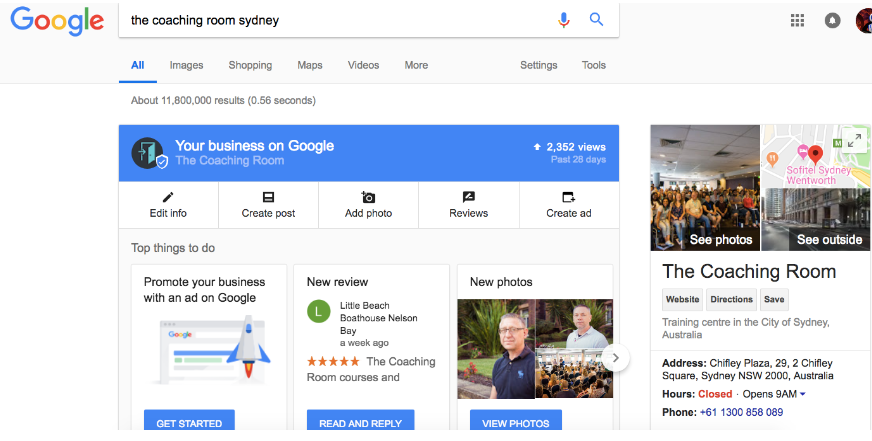
Unlike Facebook, we only have 24 reviews but with an average of ‘5’ out of 5 as a score.
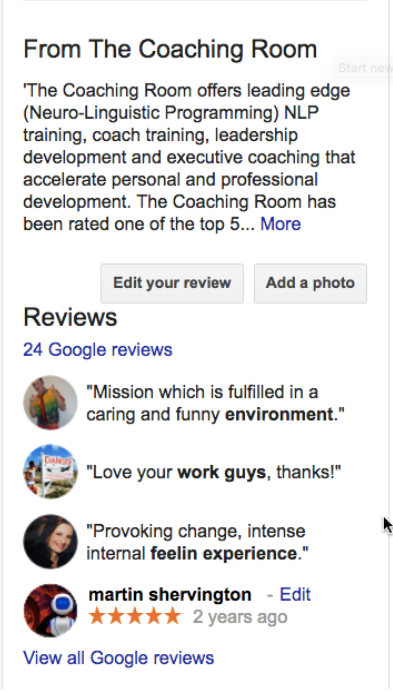
Recently, at Jay’s request, we uploaded numerous geo-located images to the listing.
Section 5.6 Twitter
This is used for broadcasting, but the real strength of Twitter is building relationships with key influencers - something we don’t do.
This should be considered in relation to requesting interviews/podcasts - both creating content and also building relationships, with intent.
Section 6: Organic Traffic (2018):
Section 6.1 Overview
This is now sitting at 5000 visitors a month, with a leap since March 2018, with the main volumes going to ‘relevant’ product pages.
Here is a snapshot of the year to date:
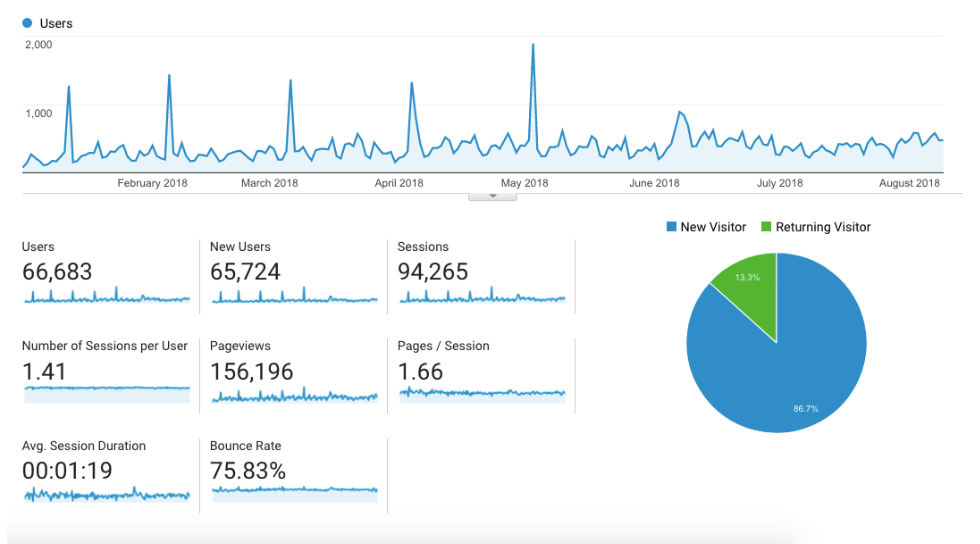
And here is a breakdown of the % of Organic, and the New vs. Returning Visitor stats:
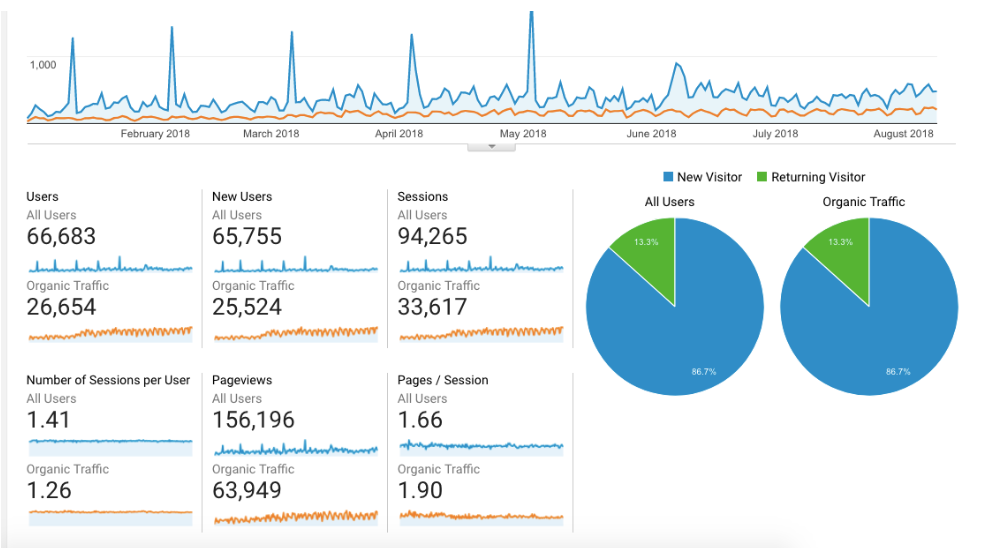
And here is a report of traffic per page compared to the same period (30 days prior to 28th August 2018) in 2017.
Section 6.2 SEO Campaign
Here are the stats from Hubspot for February: (albeit a shorter month)
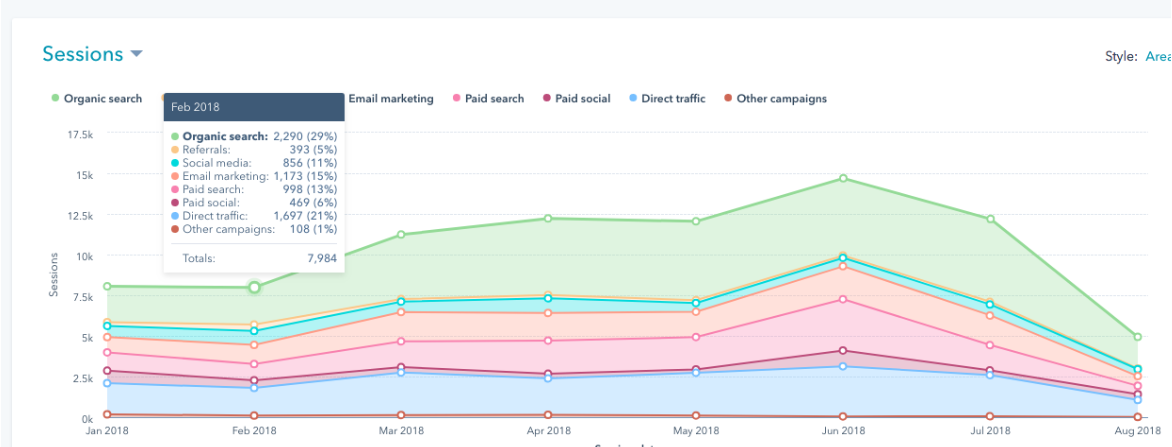
Then in March we ran an SEO campaign, including:
Increasing citation accuracy and consistency
Citation volume
Review volume and quality
Improved internal linking within the site
Backlinks from high authority/relevant pages
Geo tagged photos added to listing (in June)
Target keyword ‘pages’, shared across social (inc. my personal network)
Target keyword blog posts, shared across social
All this has contributed to a steady growth in traffic to relevant pages on the site, inc. ‘home’ and ‘/NLP’.
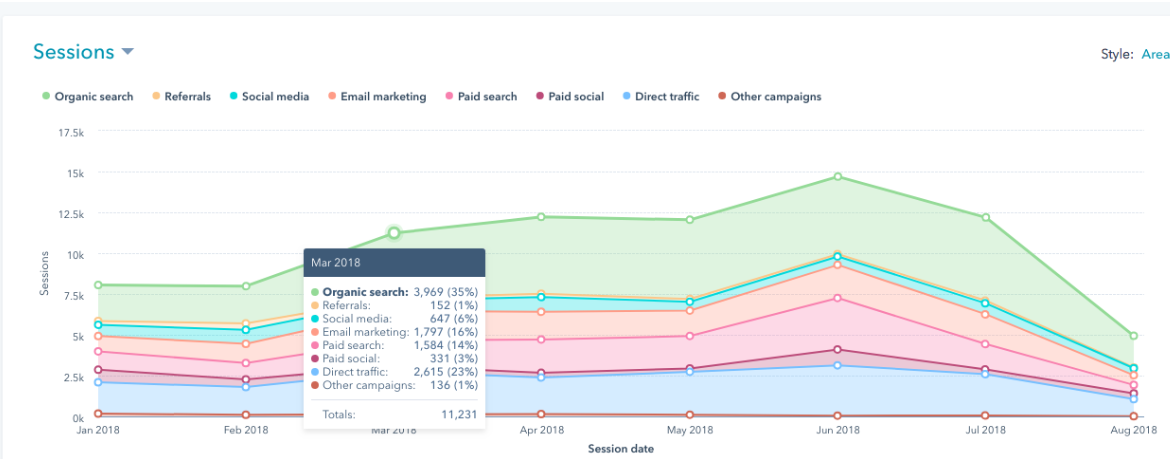
Which has led to steady growth throughout the year, as you can see from June:
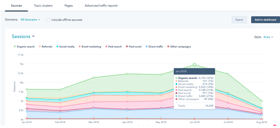
And then into July:
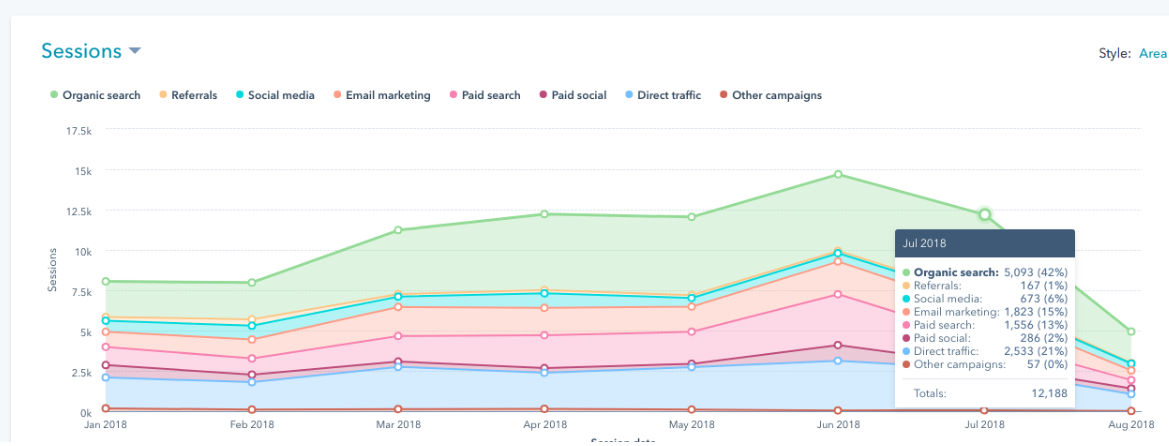
Which can be compared to last year’s (2017) biggest month:
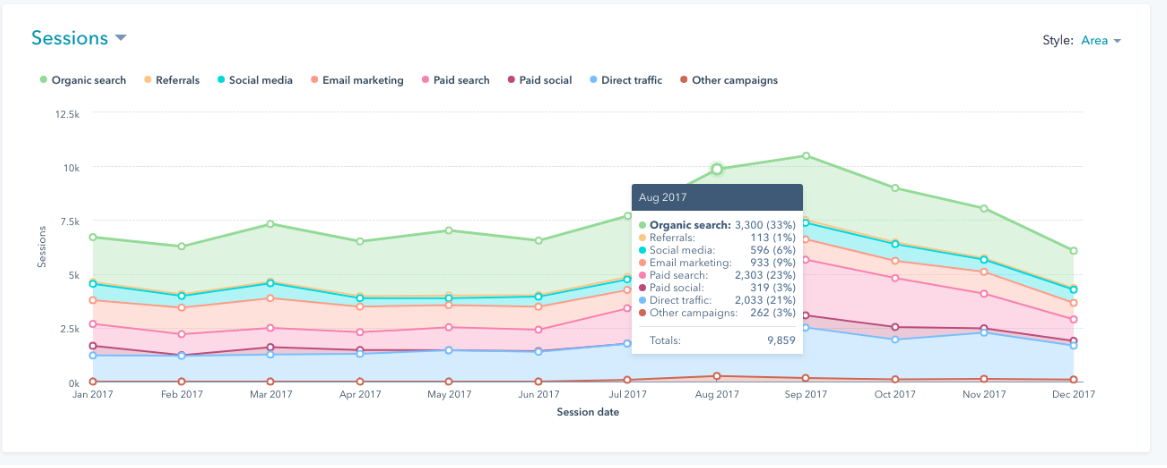
Section 7A: New Lead User Journey to ‘Customer’
In addition to the maps showing the user journey (Section 3.2 Events), this diagram gives a view of lifecycle stage movement across the stages:
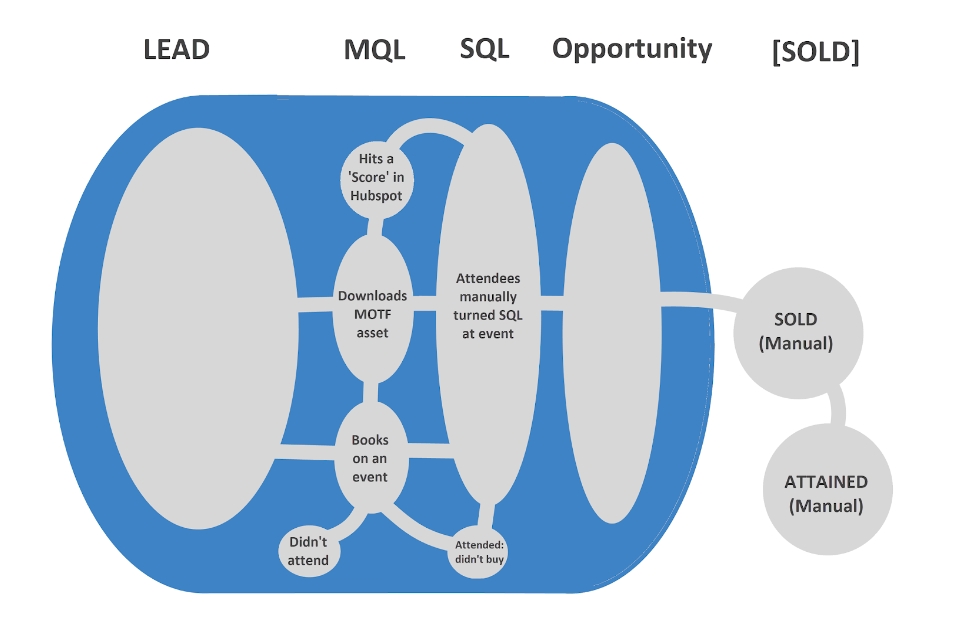
The aim is to move people from ‘pool’ to ‘pool’ (stage to stage), and to assist this process we employ several methods, including retargeting and remarketing to ‘Leads’.
This moves them to the next stage:
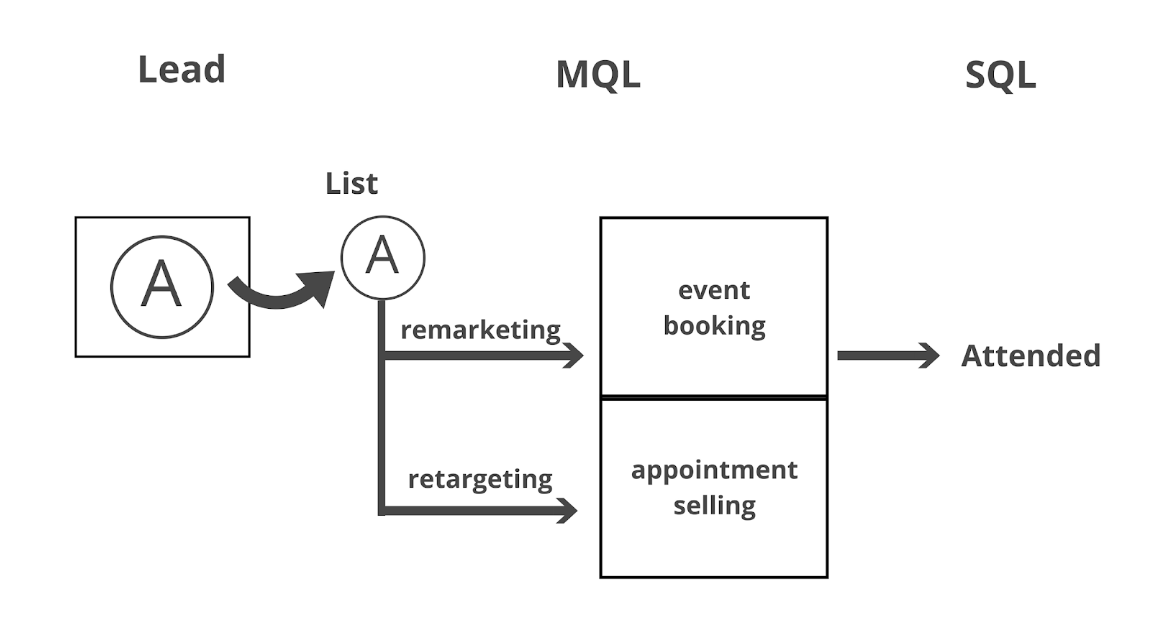
In addition to this, we employ a series of emails and phone calls to move the person forward.
This process is based on feedback at each stage as to what is working. If an email open rate is only 25% then 3 out of 4 people are missing that communication; as such, we need to communicate via additional channels e.g. phone/text.
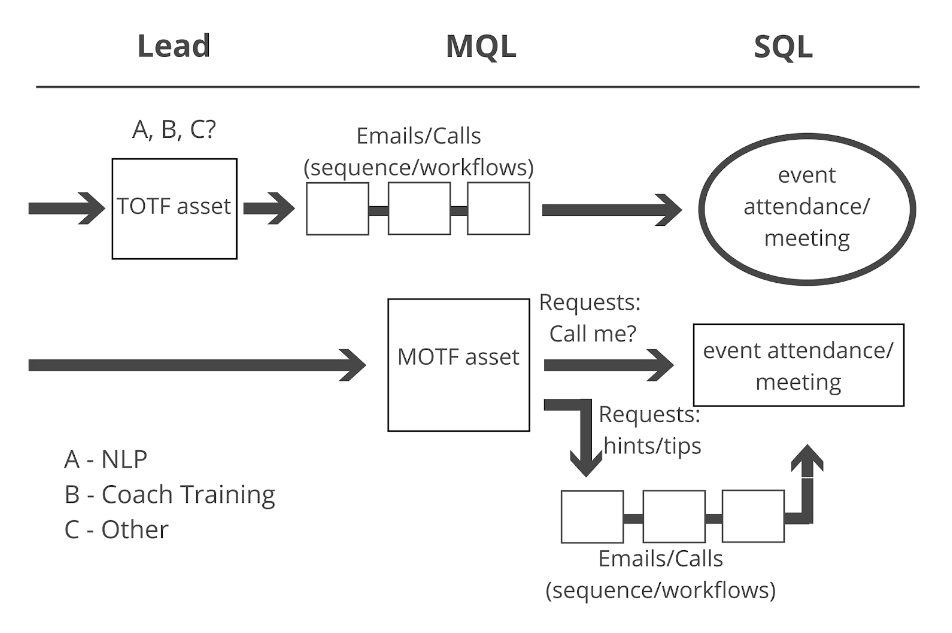
As well as personalised communication (via email sequences, phone calls) all contacts receive the weekly newsletter, and those who engage are moved on to lists (see below).
In terms of ‘breakdowns’ at the conversion, for the past 3 weeks we have been working with Sales to better move people from stage to stage.
As of today, I am pleased to say, I feel this process is beginning to work.
Section 7A.1 Running Experiments
There are many factors that we test, including:
- A/B test on Ads (inc. images)
- A/B tests on Landing Pages
- A/B tests on CTAs within emails
- A/B tests of CTAs on blog posts
- A/B tests on Subject Line
- A/B tests on Content and Offers
- Text message testing for both sign up and improving event attendance numbers
These test everything from: opt in rates, to email open rates, to click rate etc.
Once we have assessed the success of a variant on e.g. a sample size of 300 leads we will roll out the successful approach/approaches for the rest of the email list for that campaign.
Section 7A.2 Progressive Profiling
We use progressive profiling for Forms i.e. for a second download, we ask additional questions to deepen our understanding of a person’s needs.
Right now we are not using this to educate user journey (i.e. nurture paths) or Sale process enough. We have plan to optimise this in September.
Section 7A.3 Smart Forms
Smart Forms allow an existing contact to ‘see’ an alternative form on a page once opted in to the original.
The challenge is that the image above the form does not change when the second version appears, creating confusion.
On the advise of Hubspot we focused on Progressive profiling over the utilisation of Smart Forms - but we will be looking at how both can be used together more effectively.
Section 7A.4 Personas
We have personas set up in Hubspot and these should be used in conjunction with: progressive profiling, website pages visited, and Sales Team’s discretion.
Right now we are mainly only ‘streaming people’: NLP or Coaching Training (with lesser volumes at Exec Coaching, Leadership). This is not as nuanced as e.g. a small business owner interested in NLP/a HR professional interested in NLP.
Once the initial funnel stages are more robust this approach will be brought in for follow up email workflows.
Section 7: Database Segmentation, and Lists
Section 7.1 Overview
There are 17,000 contacts within the database, and we segment the lists based on several principles including: lifecycle stage/contact ownership, product vertical interest (NLP/Coach Training/Leadership etc), segmentation based on stage in user journey, and ones based on activities (e.g. CTAs clicked). We also have segmented lists based ‘Hubspot score’ and last activity date of record.
Here is a glimpse of sample lists the marketing team used from June 1st to July 1st
Section 7.2 Segmentation based on Lifecycle stage (inc. lists for the Sales Team)
Each contact is at a certain lifecycle stage and ‘owned’ by a team member.
Since August 2018 we are launching changes (see ‘sales management’ for more detail) to display the volume of team member’s contacts at each stage of the funnel.
As shown in this spreadsheet.
Each team member has a list associated with each lifecycle stage, with a naming convention: [CONTACT OWNER JAY: X] e.g. for Jay:
Evangelist - https://app.hubspot.com/contacts/468984/lists/5474
Customer - https://app.hubspot.com/contacts/468984/lists/5373
Opportunity - https://app.hubspot.com/contacts/468984/lists/5372
SQL - https://app.hubspot.com/contacts/468984/lists/5371
MQL - https://app.hubspot.com/contacts/468984/lists/5355
Lead - https://app.hubspot.com/contacts/468984/lists/5374
Subscriber - https://app.hubspot.com/contacts/468984/lists/5475
Every contact that is not under management i.e. doesn’t have a future task set, is moved back to ‘Marketing’ for processing and potentially re-allocation.
Section 7.3 Segmentation based on interest
Additionally, we segment based on the following:
Product interest - NLP, Become a Coach (i.e. Coach Training), Leadership, Executive Coaching, and Other
Each one follow a naming convention e.g.
[POTENTIAL: NLP PRACTITIONER - SQLs/OPPORTUNITIES]
Moving through the lifecycle stage to:
[COURSE BOOKED: NLP PRACTITIONER] - date/location
And once completed to a list named:
[ATTAINED: NLP PRACTITIONER]
Section 7.4 Segmentation based on stage on user journey
Following this principle we can then market more cleanly to the appropriate people the next stage in their journey, e.g. a customer who has bought NLP Practitioner, and not bought Master Practitioner.
Note: we are still working to refine ‘who should be on certain lists’ as records have not been perfectly kept up to date.
Section 7.5 Segmentation based on ‘activities’
Additionally, we generate ‘Sales Call Lists’ for follow up based on actions taken from a) CTAs in emails, b) CTAs on site (when opted in) - given more refined lists e.g.
[SALES CALL LIST: NLP PRACTITIONER] Clicked "Call me" in 2 for 1 NLP Practitioner email
Section 7.6 Segmentation based ‘Hubspot score’ and last activity date of record
This allows us to find engaged contacts from e.g. old enquiries, or imported lists. Re-engagement campaigns can then be run, as we are doing in Tasmania for NL/T leads with Steph (removing them from the database when totally ‘dead’ and not a historic customer).
Section 7.7 Additional info:
Due to the email marketing suppression within Hubspot, we are now using Lists as a way to give Sales Team members, inc. Directors, lists for outreach via email from themselves directly. This ensures the database is being ‘worked’ and people are not missing messages. See below.
Section 8: Email marketing
Section 8.1 Overview
The intent behind all email messages is a measurable outcome.
Using different methods of CTAs within Hubspot we move people onto lists e.g. A) for those looking at a brochure, and B) for those who request a call, as mentioned above.
In addition, people could book on an info night, or could call in to discuss a program, depending on the promotional intent (and the list/stage in the funnel).
There are several different types/approaches to emails that we take, including the following...
Section 8.2 Weekly Newsletter
This is scheduled for 8am every Sunday, and acts as a way to give:
Sales messages/Offers
Upcoming course dates
Blog content from the week
We have been testing Smart Content’, effectively creating 3 personalised newsletters (so far) based on ‘lists’ to that audience.
A Hubspot list has then been created with the most engaged people (i.e. those who click links within the email, visiting ‘offer pages’ or blogs). This is handed to the marketing team for follow up, where appropriate.
Open rate for the past 4 weeks between: 23.25-31.08%
Section 8.3 2 hour info sessions
For individuals who have not yet attended a session, and are primarily Leads or MQLs, we email info on upcoming evenings to drive sign ups.
Section 8.4 Women in Leadership
These are now considered within the realm of ‘info sessions’, and marketed to two lists: Sydney and Melbourne.
Note: the sales team needs to keep adding to these lists in order for the new database contacts to receive the mailings.
Section 8.5 Coach Training
We ran info night sessions for Coach Training, and were unsuccessful despite a well run campaign.
IMAGE
We have decide to ‘regroup’, focus on the product and look to a) test webinars, and then b) relook at events later this year.
Section 8.6 Product promotions, e.g. NLP Practitioner
As a specific campaign in August we are offering 2 for 1 on NLP Practitioner bookings for 2018/9, this included:
Email promotion to segmented list (i.e. non-customers)
New landing page for offer - here
Offer promoted on:
Facebook (new targets), and Facebook (retargeting to existing visitors), Facebook (retargeting to Hubspot lists)
Adwords - included in Ads for e.g. Search Term: NLP Practitioner, and NLP (i.e. broader), and remarketing to a) visitors (i.e. not opted in yet), and b) those who have opted in.
Social - via TCR user profiles
Section 8.7 Product promotions to existing customers, e.g. NLP Master Practitioner
The first wave was email promotion (click!) to the eligible list, with...
Early Bird Offers:
$1000 off in July (date passed now)
$500 off in August
Then, through tracking the number on the list (550 people) vs. the number sent (361), we worked out we needed a second approach. Even with a 50% open rate, but are still missing the chance to communicate with hundreds of people.
Hubspot’s ‘suppression list’ kicks in for marketing emails when a person doesn’t open more than 12 emails. BUT it can be bi-passed by an individual sending to a contact directly. As such we will approach the list by Email Sequences (i.e. personalised mini-workflows) from the Directors. Each person has chosen members of their own list, and they will outreach in August/September.
Section 8.8 Product promotions to existing customers, e.g. CCMS
Having segmented the list of suitable candidates (e.g. done ACMC training), we ran a ‘pre-campaign’ for a ‘Personal and Professional Development Check in’ with Jay - mailing to a small list to book an appointment, i.e. soft selling the program.
Jay says the conversion rate was excellent from the 4 or 5 appointments booked, with some opting for other programs.
We then followed up with this video, contained in this email.
We then did a last chance email to the list.
Section 8.9 New Product promotions, e.g. Leadership
In this campaign we did a split test to a sample size of 300 people each for:
2 for 1, and
50% off
Before determining the best option to send to the rest of the list.
Note: Subject line is the primary factor that influences open rates (so we split test the location of e.g. ‘50% off - Special Offer’ at the start vs. ‘Special Offer: 50% off’; ‘Offers’ will determine the response rate.
Sample email here.
Section 8.10 New Product promotions, e.g. Parenting
This is a new program, so in the early stages of testing ‘what works’.
We warmed people up for the campaign aspect of this new course by including a CTA to download a PDF:
https://www.thecoachingroom.com.au/enlightened-parenting-tips
As with all CTAs, once clicked people are moved onto a [SALE CALL LIST: e.g. PARENTING] for follow up by the Sale Team, once the launch has happened.
The following week we sent the promotion email, list wide.
Then, over a period of 4 weeks we posted 4 blog posts on the subject of ‘Parenting’, all of which has CTAs through to the Product landing page. Again, anyone who clicked a CTA goes on the list, assuming they’ve opted in.
Next week we are working on new contact opt ins, as well as retargeting and remarketing.
Section 8.11 ‘Workflows’
I have paused all automated workflows beyond initial content delivery.
These will be re-built by end September, instead we are doing the same approach as a workflow using email sequences to garner the much needed feedback as to what people want and what they will respond to when emailed.
With an open rate of only 25% (avg.) for historic generic emails we are losing interactions with 3 out of 4 people. Instead we are driving them (using sequences) to either a) get on a call, or b) attend an event.
Without feedback on every email sent we are going to fail to even engage the 25% that do open. Once we know what works - email/text/phone/webinar - we will optimise the funnel.
Note: in effect we use Facebook retargeting, and Adwords remarketing, as part of the ‘workflow’ process (e.g. moving people from TOTF to MOTF).
Section 8.12 ‘Sequences’
This approach to emails is still being tested, but allows up to 150 emails (with automated follow up) per day.
We are approaching lists with different sequences, and using it as a method of quickening personalised focused communication - allowing for more nuanced communication based on any factor in their record (e.g. location, company, job role, course interest, website product page visits, blog visits, TOTF downloads, source info e.g. PPC keyword, campaign etc)
Stats can lie on this one (as some people may respond ‘no thank you’), but people respond ‘as if it was email’ (as it was) e.g. when looking at Event Attendance.
Section 9: Pay Per Click, and related expenditure
In 2017 $75,000 spent on Adwords (and Facebook)
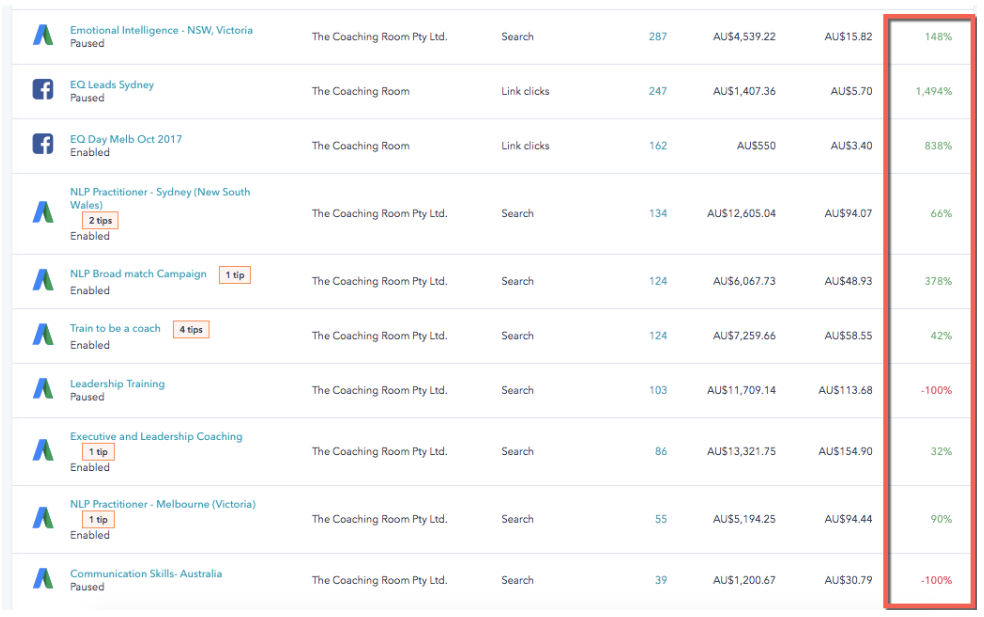
Section 9.1 ROI for 2018

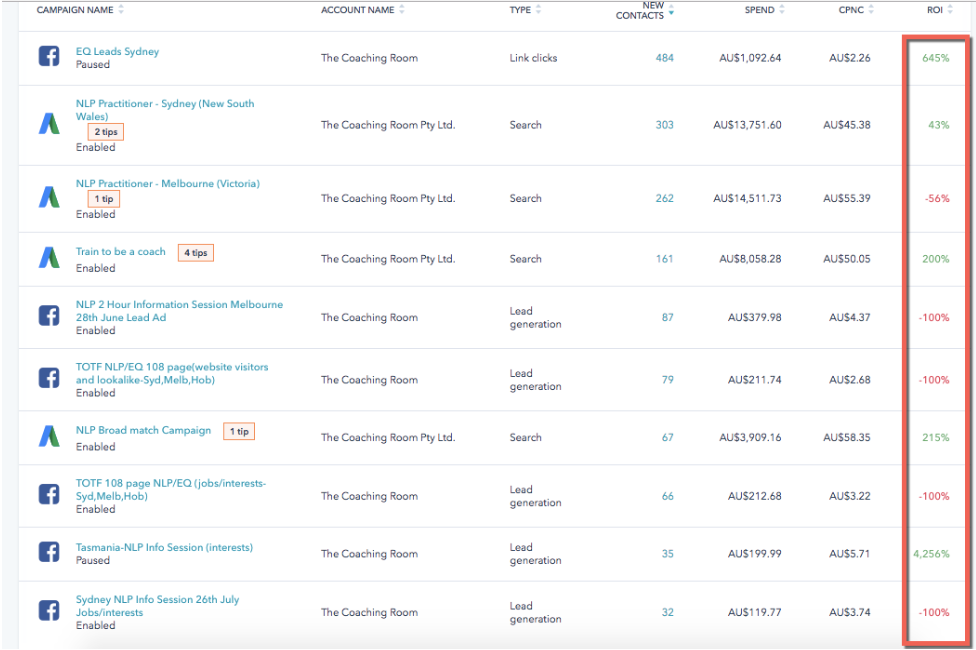
We don’t have a formal marketing budget, for on and offline activities.
The digital marketing budget is semi-officially $10,000
This is currently split as follows for July 2018:
Facebook - 15%
Google Adwords - 85%
LinkedIn - $0
Note: We have had poor results with LinkedIn Advertising to date - in part as Hubspot doesn’t integrate with LinkedIn, so we cannot track the success (i.e. cost of acquisition/sales) per campaign.
Here is a snapshot of Adwords for July:
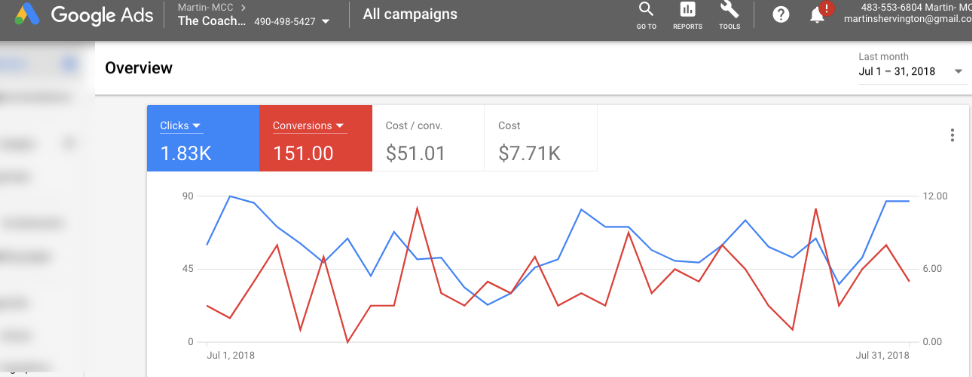
Note: not all conversion are the same - We have shifted from TOTF conversions back to MOTF conversions (costs avg. $50 an MQL) as we are pushing people to:
a) Events (when general interest e.g. ‘NLP’), and
b) NLP Practitioner product download (when the keyword is more like ‘NLP Practitioner’ - with intent of a sales call follow up)
We also run campaigns for Coach Training, Executive Coaching, Leadership...
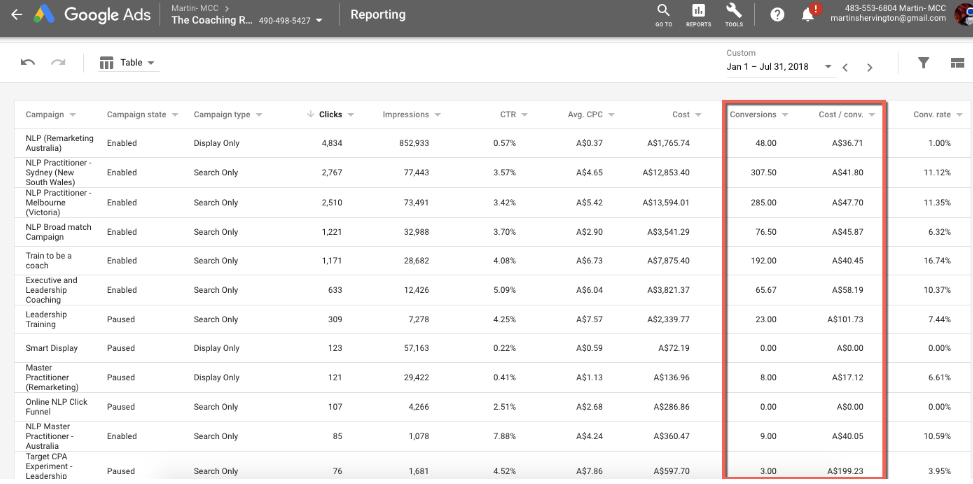
Poor investments - $11,700 spent on Leadership training in 2017: this was the investment on Adspend. Without a product that people wanted to buy we simply couldn’t convert their attention into intention.
We generated a list of 106 people from the campaign that I also feel could have been better followed up at the time.
There is one Customer (WIL) but with little follow up as marketing and sales failed to work ‘hand in hand’, and we didn’t have the Leadership Practitioner product (open program) ready. This has been resolved ready for next year.
‘Coach Training’ campaigns are not as yet working ‘well’ so are reduced until we have the new brochure (next week), and a new webinar approach from September.
Section 9.2 Remarketing
We use display and responsive adverts to remarket on Adwords to target website visitors and similar audiences.
We also use ‘Visitors’ and Hubspot lists to target Master Practitioner discount offers to that segment; we also remarket to people who don’t opt in, with a different offer e.g. TOTF when MOTF asset has failed.
Section 9.3 Facebook
Our approach to Facebook consists of the following:
Using locations, demographics, behaviour, interests and segmented contact lists from Hubspot and similar audiences.
- Standard Ad - new audience event bookings - driving people to a landing page for booking
- Lead Ads - high volume, low cost leads that need connecting with via phone/email to increase attendance (for Hobart $500 spend generated $8000+ in sales from this source)
- Re-targeting to existing Hubspot lists (similar to our approach to Adwords remarketing)
- Offers (driving to a landing page offer for e.g. 2 for 1 NLP Practitioner)
- Boosted Events (for 2 hour sessions, and Women in Leadership)
- TOTF downloads - we’ve used Facebook to generate low cost leads e.g. £3.74 for PDF opt ins but this has not yielded movement to the next stage of the funnel, unlike using other methods on Facebook (e.g. Lead Ad s)
Section 9.4 Website ‘Smart Content’
In addition to segmenting the messaging across paid networks, and in the newsletter, since August we display 3 different types of content on the homepage based upon the lists to which they belong:
Not done NLP Practitioner (default)
Eligible for Master Practitioner (i.e. existing customers, not done Master Practitioner)
Become a Coach
We will track the success of this approach over coming months.
Section 10: Sales Management
Marketing has worked more directly with Sales in August to get the database in order.
We put together an extensive Sales Charter and the other Directors have signed off the gradual implementation over coming months.
Additionally, we have audited and structured an approach to Contact Owner/Management to give transparency of how many contacts are at ‘what stage’ in the customer lifecycle journey. This spreadsheet shows the overview.
In addition, in order to meet sales targets we are starting to measure (for the sales team):
- Number of calls
- Number of emails sent
- Number of appointments made
All of which allows us to manage the ‘input’ to drive the desired output.
Section 11: Opportunities on the horizon/Recommendations
Webinars
- Testing different styles of webinar is essential now - using Facebook ads (as well as existing contacts) to market the equivalent to the 2 hour sessions.
Tests are underway for August and September. - I believe that we should embrace the Enneagram alongside NLP (Enneagram has 9000+ searches per month in Australia, as opposed ‘NLP’ with 4000)
We are all set up, but the funnel has not been built out and tested.
James is exploring using this as a ‘relationship sustainer’ for existing customers - real world first. - In a similar way, NLP is perfect for developing ‘Emotional Intelligence’ (9000+ searches on Adwords per month) and we should look at using webinars to target this niche on Facebook and Adwords.
- Similar to podcast, we should build allies (via digital) by interviewing them for existing community members - keeping a fresh flow of relevant and interesting content
- Higher level programs e.g. Spiritual Inquiry can also be tested in this way, and are in process.
2 hour sessions
- The number of attendees needs to be driven upwards, and a plan is underway.
Bringing back ‘Become a Coach’ sessions, and testing ‘Emotional Intelligence’ (and maybe Enneagram ones) would allow us to reach new online audiences,
Sales infrastructure in place
- As mentioned in Section 10 above, working closer with the sale team will enable better feedback loops as to what is working, and what isn’t - showing us what to scale and what to change. This is underway and ongoing.
Scheduling - planning
- Developing a plan for content on ‘NLP’ would continue to help for SEO purposes, and feeding the community as a whole.
This will be undertaken from September.
Get more reviews on Facebook and Google
- A campaign will be run in September with an outcome of generating an average of over 4 stars on Facebook.
Section 12: The Team
The marketing team consists of:
Martin Shervington (myself) - Director of Marketing
Elisa Shervington - Assistant to Director of Marketing
Reymalyn - Administrative Assistant
Sanjeev - Hubspot and Web design
Julie-Anne - writing staff
In terms of capability, we are a Google Partner, have Hubspot Inbound Certification and 20 years+ experience in the field of NLP/Coaching/Leadership.
I was asked to produce 3 digital marketing courses for Lynda.com (LinkedIn/Microsoft) in 2016:
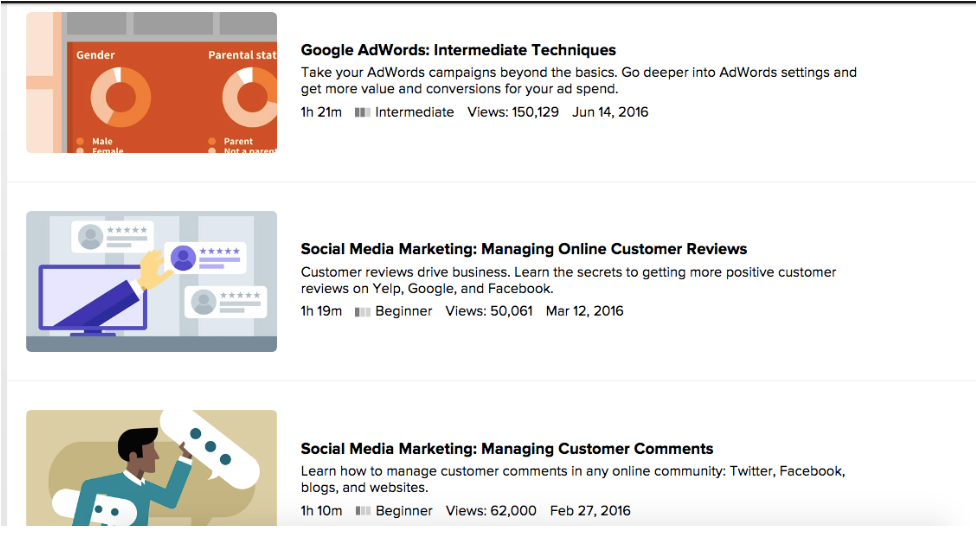
And was made by Google, 1 of 34 Google Small Business Advisors worldwide (and the only one outside of the USA).
I also have a Post Graduate Degree in Organisational Psychology, and have built up online communities with thousands of engaged members.
"Marketing Plus!"
Martin and his team have been providing all of our company’s digital and social marketing for the last 2-3 years – They have developed a pragmatic and systemic design and integral approach to our business utilising our HubSpot marketing software and their own drive and determination for Marketing results! Often operating and adding value to the business well beyond the marketing scope.”
